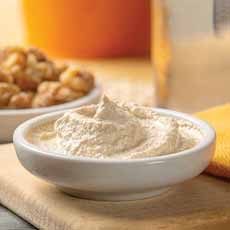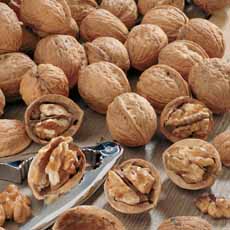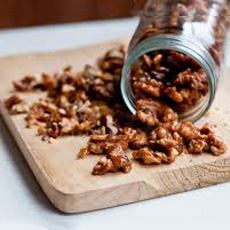RECIPE: Walnut Spread, A Versatile Spread, Filling & Thickener
|
An overly-enthusiastic purchase of a huge bag of walnut halves at a warehouse club led us to think: What on earth were we thinking? There are just so many walnut pies, salad garnishes, pasta sauces, cookies and brownies we can eat. But we hit the jackpot with what the California Walnut Board calls walnut “cream.” To avoid any relation to dairy, we call it walnut spread. It’s like hummus that tastes like nuts instead of chickpeas and tahini. It is also dairy-free, gluten-free and vegan. And like hummus, walnut spread has its own arsenal of nutrition, including heart-healthiness. Best for our jumbo bag of walnuts, you can turn it into a spread that can be used every day. The walnut spread has a rich, velvety texture and a lightly nutty flavor profile. You can use walnut spread in the same way as hummus: This recipe (photo #1) is simply a 2:1 ratio of raw walnuts to water. Walnut pieces are less costly than walnut halves. The spread is flavorful and nutty. But like hummus, you can add more dimensions of flavor with everything from chiles to olives. Ingredients For 1-1/2 Cups 1. BLEND the optional add-ins first, in a food processor. Add the nuts, pulverize and slowly add in the water. 2. TASTE and season as desired. It will keep in the fridge for several days. Here are more recipes to start you off: And one of our favorites, candied walnuts (photo #4), are great for dessert garnishes, trail mix, snacking and more. |
 [1] Walnut “cream,” dairy-free (photo courtesy California Walnut Board).
|
|
|
The wild walnut (Juglans regia) originated in central Asia, spreading in pre-historic times to western China, the Caucasus, Persia, and Europe. Archaeologists have found walnut remains in southern France dating to 17,000 thousand years (source). The cultivation of walnuts in ancient Persia dates to at least 7000 B.C.E., in the Neolithic period. There, they were reserved for royalty. The Romans called walnuts Juglans regia, “Jupiter’s royal acorn,” after the supreme god of the Roman pantheon. Neolithic peoples cultivated walnuts at least 7,000 years ago, but they were not widely cultivated in the Mediterranean until ancient Greek and Roman times. Walnuts were an item of trade, and amphorae filled with walnut residue have been salvaged in Roman ships that sank in the Mediterranean. Their significant nutrition made them an important part of the diet. By the first century C.E., Greek and Roman physicians extolled walnuts’ medicinal virtues. Walnuts were traded along the Silk Road between the Middle East and Asia. Walnut trees flourished throughout Europe during the Middle Ages, and from then until modern times, physicians described them for a variety of illnesses. When seafaring English merchants traded the product in ports around the world, the nuts became known as English walnuts, although England is not a grower of commercial walnut crops. But California is. The Golden State has become the source of the world’s best walnuts, first cultivated there by Franciscan fathers in the late 1700s. California walnuts are harvested in the fall, typically from mid-September to early November. They’re ready to harvest begins when the green hulls (photo #3) split. In modern farming, the nuts are removed from the tree using a mechanical shaker, a machine that grasps the trunk and shakes the whole tree. The nuts drop to the ground, are swept into rows (windrows) and gathered up with harvest machinery. The green hulls are then removed with a huller, exposing the familiar hard brown shell (photo #2). The shells are cleaned with wet scrubbers and dried in gas dryers. While some consumers buy the nuts in the shell, most are cracked, graded and packaged and sold sold to consumers as nutmeats (source). *Think of great pairings, like mushroom soup with walnut thickener, or chicken with walnut sauce.
|
||


